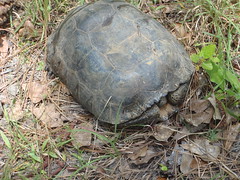Pictures by John S. Quarterman, Lowndes County, Georgia, 17 March 2011.
More dogwoods of previous years.
-jsq
Pictures by John S. Quarterman, Lowndes County, Georgia, 17 March 2011.
More dogwoods of previous years.
-jsq
It’s harmless, except to small rodents that live in corn fields. Elaphe guttata is a constrictor. This one was 3 or 4 feet long. They’re native to the U.S. southeast from New Jersey to Texas. I did not know until that day that corn snakes can climb trees.
Here he is stretched out: Continue reading
a high-climbing, woody vine that is known by several names, including Carolina jessamine, poor man’s rope, or yellow jasmin.It smells good. It’s native to the U.S. southeast.
Pictures by John S. Quarterman, Lowndes County, Georgia, 28 February 2011.
-jsq
About Longleaf (Pinus palustris), wiregrass (Aristida stricta), and gopher tortoise (Gopherus polyphemus) by the Longleaf Alliance:
We believe that longleaf in any form is better than a cotton field; that longleaf and native ground cover (like wiregrass) is better than longleaf alone; that longleaf, wiregrass, and gopher tortoises are better than longleaf and wiregrass alone.
Picture of Pinus palustris and Aristida stricta by John S. Quarterman, Lowndes County, Georgia, 19 February 2011.
-jsq
 It’s probably this gopher.
It’s probably this gopher.
The gopher tortoise (Gopherus polyphemus) is named for its burrowing skills. Its shovel-shaped forefeet dig burrows up to 40 feet long that shelter and house not only tortoises, but a virtual zoo. By one count, an astonishing 362 animals take refuge in these burrows, from gopher frogs and burrowing owls to an array of snakes and invertebrates, some species depend entirely on them. If we lacked the scientific concept of a keystone species–one with an impact far beyond that expected from its numbers–we’d need to create it for the gopher tortoise, given its importance in the longleaf forest ecosystem.
Picture of Gopherus polyphemus front porch by John S. Quarterman, Lowndes County, Georgia, 19 February 2011.
-jsq
 Waiting, boarding, and watching it go after the return:
the train at Jesup.
Waiting, boarding, and watching it go after the return:
the train at Jesup.
Gretchen Quarterman at the Amtrak Station, Jesup, Georgia, 17 and 25 Feb 2011, along with a bunch of women from Brunswick on their annual outing to NYC, and around a dozen other passengers. Videos by John S. Quarterman.
-jsq
Well, I was digging a trench for an electric line and I wanted it deep where I have a shallow ditch. So “Call before you dig!”
I called myself, “Self, where’s that sewer pipe you put in a few years ago?” Continue reading